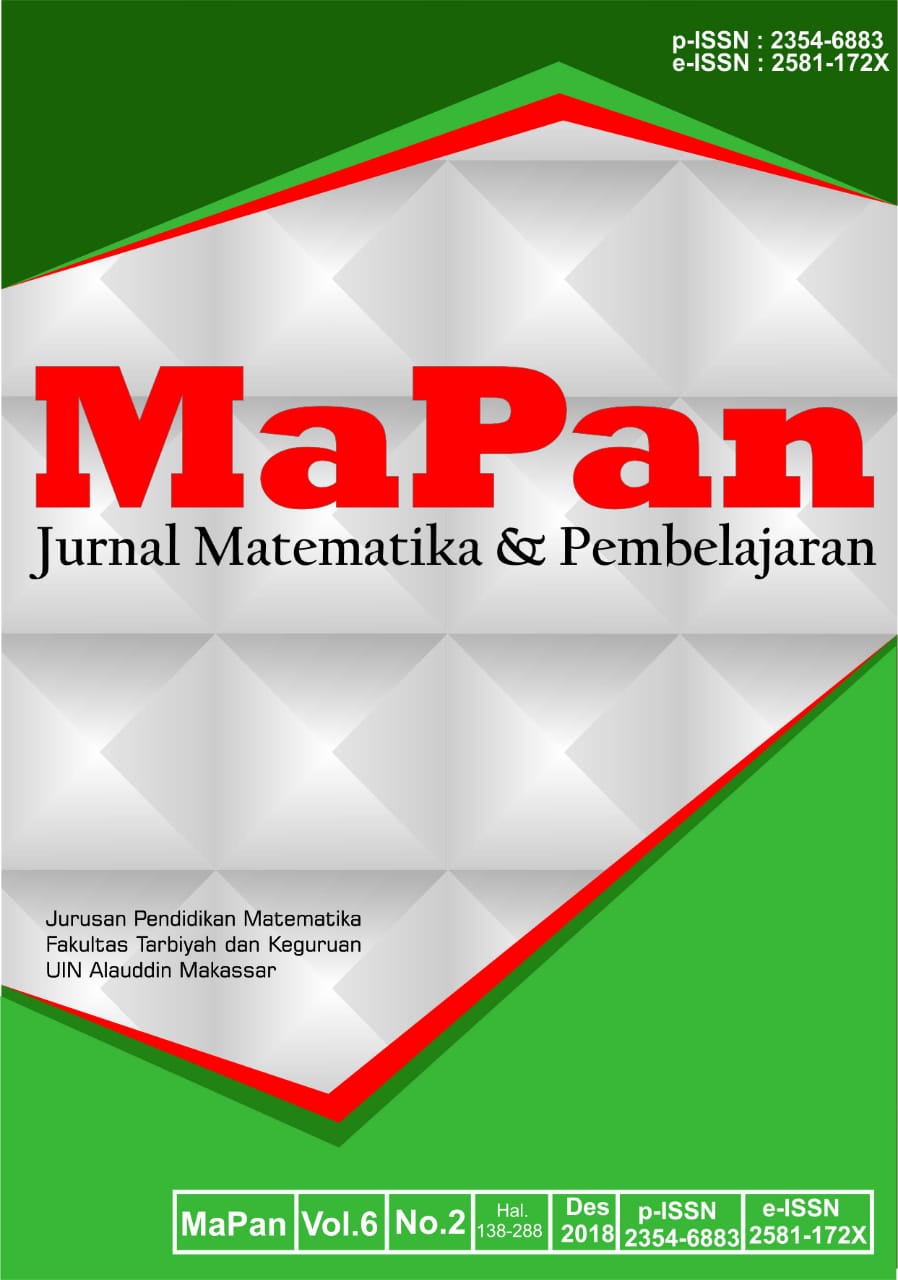MATHEMATICAL LEARNING OUTCOME DIFFERENCES THROUGH THE IMPLEMENTATION OF COOPERATIVE LEARNING MODEL OF THINK PAIR SHARE TYPE, TWO STAY TWO STRAY TYPE, AND NUMBER HEAD TOGETHER TYPE
Abstract
Abstract:
The study aims to find out the students’ mathematical learning outcome differences through the implementation of cooperative learning model of Think Pair Share (TPS) type, Two Stay Two Stray (TSTS) type, and Numbered Heads Together (NHT) type. The study used quasi-experimental research design. The population of this study was all the second grade students of SMPN 1 Pallangga that consisted of 11 classes with the total number of 343 students. The sample was determined by using purposive sampling technique. The data analyses techniques used were descriptive and inferential statistics by using F one-way Anova test and follow-up testing by using Scheffe test. Based on the statistics analysis, it was found that there were the students’ mathematical learning outcome differences through the implementation of Think Pair Share (TPS) type, and Two Stay Two Stray (TSTS) type at the second grade of SMPN 1 Pallangga. Based on the mean scores, the highest score of the students’ learning outcomes was the experimental class implemented learning model of TPS type.
Abstrak:
Penelitian ini bertujuan untuk mengetahui perbedaan hasil belajar matematika siswa melalui penerapan model pembelajaran kooperatif tipe Think Pair Share (TPS), Two Stay Two Stray (TSTS), dan Numbered Heads Together (NHT). Jenis penelitian ini menggunakan quasi experiment. Populasi pada penelitian ini adalah seluruh peserta didik kelas VII SMPN 1 Pallangga yang terdiri dari 11 kelas, yang berjumlahkan 343 siswa. Penentuan sampel dengan menggunakan teknik purposive sampling. Teknik analisis data yang digunakan adalah statistik deskriptif dan analisis statistik inferensial dengan menggunakan uji F one-way Anava dan uji lanjut dengan menggunakan uji Scheffe. Berdasarkan analisis statistika menunjukkan bahwa terdapat perbedaan hasil belajar matemaika siswa melalui penerapan model pembelajaran kooperatif tipe Think Pair Share (TPS), Two Stay Two Stray (TSTS), dan Numbered Heads Together (NHT) pada kelas VII SMPN 1 Pallangga. Berdasarkan nilai rerata, hasil belajar matematika siswa yang tertinggi adalah kelas eksperimen yang menerapkan model pembelajaran tipe TPS.
Downloads
References
Aqib, Z. (2013). Model-model, media, dan strategi pembelajaran. Bandung: Yrama Widya.
Ernest, P. (2014). The philosophy of mathematics education. British Library Cataloguing in Publication Data.
Harahap, K. A., & Suryab, E. (2017). Application of cooperative learning model with type of two stay two stray to improve results of mathematics teaching. International Journal of Sciences: Basic and Applied Research (IJSBAR), 33(2), 156–165. Retrieved from http://gssrr.org/index.php?journal=JournalOfBasicAndApplied&page=article&op=view&path%5B%5D=7370&path%5B%5D=3456
Hasanah, M., Idrus, A. Al, & Mertha, I. G. (2015). Perbedaan hasil belajar ipa biologi menggunakan model pembelajaran kooperatif tipe numbered heads together (NHT) dengan think pair share (TPS) pada siswa kelas VIII SMPN 13 Mataram Tahun Ajaran 2015/2016. Jurnal Tadris IPA Biologi FITK IAIN Mataram, 7(2), 211–225. Retrieved from https://anzdoc.com/abstrak-kata-kunci-pembelajaran-kooperatif-think-pair-share-.html
Kusumaningrum, R., Budiyono, B., & Subanti, S. (2015). Eksperimentasi model pembelajaran kooperatif tipe two stay two stray (TSTS), numbered heads together (NHT), dan think pair share (TPS) pada materi lingkaran ditinjau dari kreativitas belajar matematika siswa SMP Negeri di Kabupaten Sukoharjo. Jurnal Elektronik Pembelajaran Matematika, 3(7), 705–716. Retrieved from http://jurnal.fkip.uns.ac.id/index.php/s2math/article/view/6488/4428
Nasution, Y. S., & Surya, E. (2017). Application of TPS type cooperative learning in improving students’ mathematics learning outcomes. International Journal of Sciences: Basic and Applied Research (IJSBAR), 34(1), 116–125. Retrieved from http://gssrr.org/index.php?journal=JournalOfBasicAndApplied&page=article&op=view&path%5B%5D=7564&path%5B%5D=3514
Riska, Safei, & Afiif, A. (2015). Perbandingan kemampuan kerjasama dan berpikir kreatif peserta didik melalui penerapan model kooperatif tipe think pair share dan two stay two stray. Jurnal Ilmiah Pendidikan Fisika, 3(1), 68–71. Retrieved from http://journal.uin-alauddin.ac.id/index.php/PendidikanFisika/article/view/4102/3792
Rozaiah, N., Wati, M., & Mastuang. (2017). Perbedaan hasil belajar siswa menggunakan model pembelajaran kooperatif tipe think pair share (TPS) dengan tipe two stay two stray (TSTS) pada kelas XI IPA SMA Negeri 4 Banjarmasin. Jurnal Ilmiah Pendidikan Fisika, 1(1), 50–63. Retrieved from https://anzdoc.com/nazua-rozaiah-mustika-wati-mastuang-prodi-pendidikan-fisika-.html
Shoimin, A. (2016). 68 Model pembelajaran inovatif. Yogyakarta: Ar-Ruzz Media.
Zainuddin, Budiyono, & Sujadi, I. (2014). Eksperimentasi model pembelajaran kooperatif tipe two stay two stray dan numbered heads together pada materi pokok fungsi ditinjau dari kecerdasan interpersonal siswa kelas VIII SMP Negeri Se-Kota Surakarta. Jurnal Elektronik Pembelajaran Matematika, 2(2), 121–130. Retrieved from http://jurnal.fkip.uns.ac.id/index.php/s2math/article/view/3884/2750
Copyright (c) 2018 Ira Syamsuarni, Fitriani Nur, Nur Khalisah Latuconsinah

This work is licensed under a Creative Commons Attribution 4.0 International License.


